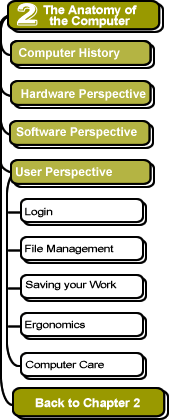

|
File Management
A computer is like a large digital filing cabinet. It stores information like sounds, letters, documents, programs, and much more on a storage device. This information might be stored internally on the computer's hard drive, or on a floppy disk, optical disk, or other storage device.
Each collection of digital information is stored in a file. For example, one file might contain a picture, another file might contain a webpage, and another might contain a program.
Because a computer can hold tens of thousands of files, these files are organized into containers called folders. Folders, also known as directories, contain files but can also contain other folders (sometimes called subfolders).
The example below shows how the Windows operating system is organized. Because it uses a GUI (graphical user interface), you navigate through folders and files with a mouse. On text-based operating systems, you must enter commands at the keyboard.

![]()
![]()
These pages were written by Steven H. VanderLeest and Jeffrey Nyhoff and edited by Nancy Zylstra
©2005 Calvin University (formerly Calvin College), All Rights Reserved
If you encounter technical errors, contact computing@calvin.edu.